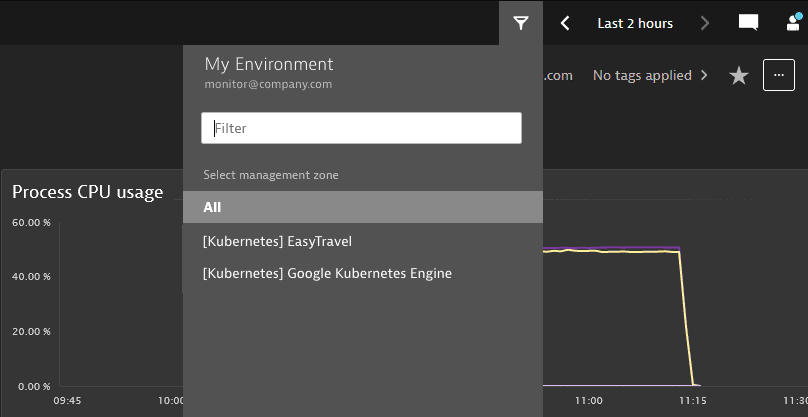Migrate role-based permissions to Dynatrace IAM
Dynatrace version 1.252+
Dynatrace security policies now support the classic role-based permissions, which means that you can control all access to a Dynatrace environment using only the IAM framework and use security policies to define user/group authorization in your environment via either the Dynatrace web UI and or the Dynatrace API.
Environment permissions
To ease migration to security policies, you can now use existing environment permissions in your policy statements and bind them to groups.
Example 1: policy for an application developer
For example, to create a policy for a typical application developer, you'd want to provide them with the following:
- Access to all settings in
devandhardeningALLOW environment:roles:manage-settingsWHERE environment:management-zone IN ("dev", "hardening"); - Read access in
prodALLOW environment:roles:viewerWHERE environment:management-zone IN ("prod");
Example 2: monitoring parts of the environment
-
Create a policy granting full access to the environment.
ALLOW environment:roles:viewer, environment:roles:manage-settings; -
A user from a group to which this policy is bound has full access to the environment.

-
Modify the policy to limit access to selected management zones based on name prefix (in this example,
“[Kubernetes]”).ALLOW environment:roles:viewer, environment:roles:manage-settingsWHERE environment:management-zone startsWith "[Kubernetes]"; -
Now the user has access only to the management zones with names starting with
“[Kubernetes]”.
Learn how to create policies.
Management zone permissions
To create a management zone permission to IAM, use the environment:management-zone attribute in your policy statement. For example, to limit log viewing to a selected management zone, use the following statement:
ALLOW environment:roles:logviewerWHERE environment:management-zone IN ("my-management-zone");
Role names
Use the following role names in your policy statements.
| Current role name | IAM role name | Management zone condition | Monitoring data access |
|---|---|---|---|
| View environment | roles:viewer | ||
| Manage monitoring settings | roles:manage-settings | ||
| Manage capturing of sensitive request data | roles:configure-request-capture-data | ||
| Install OneAgent | roles:agent-install | ||
| Manage security problems | roles:manage-security-problems | ||
| View security problems | roles:view-security-problems | ||
| Replay sessions without masking | roles:replay-sessions-without-masking | ||
| Replay sessions with masking | roles:replay-sessions-with-masking | ||
| View logs | roles:logviewer | ||
| View sensitive request data | roles:view-sensitive-request-data |
Role permissions can be divided into two groups:
Permissions granting access to monitoring data
Permissions that can be used to extend basic monitoring data access, which on their own do not grant access to the environment
For example, a policy with a manage-settings role also allows a user to access the web UI, but a policy with a logviewer permission also requires viewer permission to grant access to the web UI.
Policy statement syntax
In its most basic form, a policy statement for environment permissions starts with the ALLOW keyword, which is followed by environment:roles, and then a role name. A statement can include an optional management zone condition.
ALLOW environment:roles:<role name> WHERE environment:management-zone = "<name of management zone>";
Use the following syntax in your policy statements.
- Allow a role
ALLOW environment:roles:<role name>;
- Allow a role in a management zone
ALLOW environment:roles:<role name> WHERE environment:management-zone = "<name of management zone>";
- Allow a role in a number of management zones
ALLOW environment:roles:<role name> WHERE environment:management-zone IN ("<name of management zone 1>", "<name of management zone n>");
Policies don't restrict classic role-based permissions
As you migrate your role-based access to IAM framework, note that role-based permissions and security policies are additive. This means that you can't limit an environment permission with a more restrictive policy.
For example, if an environment permission is assigned to a user, and then you assign this user to an IAM group with a policy-based role restricted to a management zone, the environment permission still grants access to a whole environment, including all management zones.
User search limitation
While performing a user search (for example, when trying to share a dashboard), some users might not appear in the results. This is currently a known limitation that affects users who have only IAM policies, without any role-based permissions. As a workaround, please assign any permission to such a user and they will then appear in the user search results.